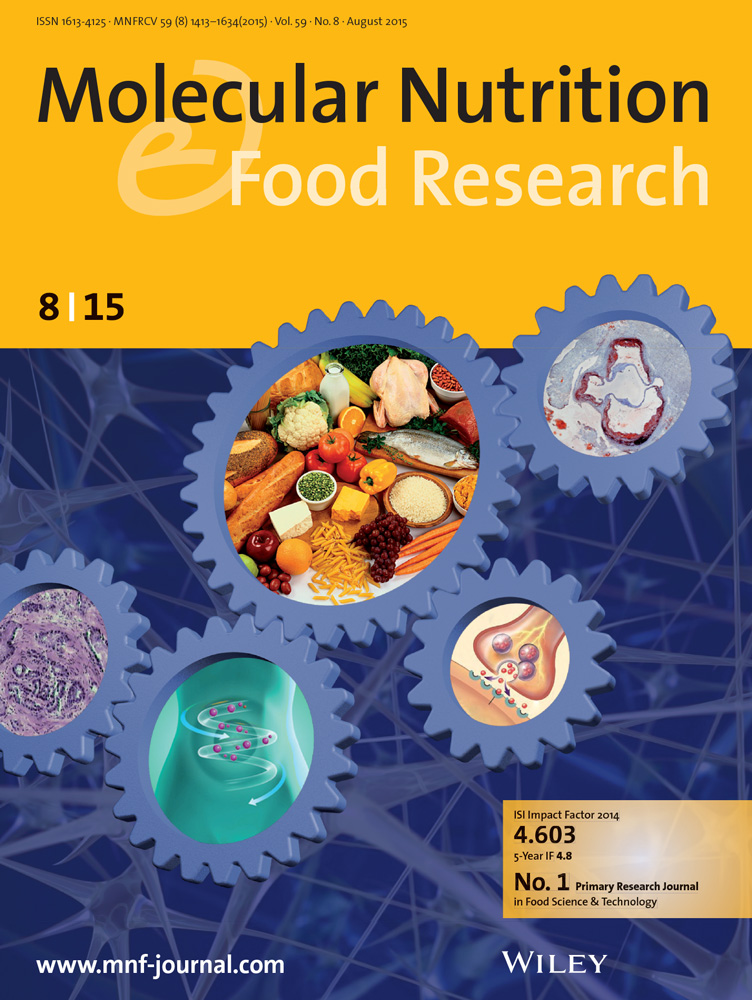从烘焙Açaí (Euterpe oleracea)种子中提取的升级饮料:通过胃肠道模拟的抗氧化能力和细胞保护。
IF 4.2
2区 农林科学
Q1 FOOD SCIENCE & TECHNOLOGY
引用次数: 0
摘要
巴西莓籽被用于烘焙过程,从而产生一种类似于咖啡的渗透饮料。这种升级后的产品已经获得了市场份额,为消费者提供了一种具有功能吸引力的无咖啡因饮料。然而,关于这种粉末和饮料的信息有限。因此,本研究旨在评估巴西巴西莓烘焙种子样品的化学特征,研究体外消化前后的酚类化合物和抗氧化活性,并研究Caco-2细胞培养中的细胞毒性/细胞保护作用。来自北部、东北部和东南部的6种商品样品具有高碳水化合物含量、高酸度和高水分含量的特征(≤5 g/100 g)。在体外消化后,所有饮料都显示出更高浓度的单宁和类黄酮,以及更大的吸收氧自由基的能力。然而,对DPPH和ABTS自由基的抗氧化能力以及铁离子的还原作用都有所降低。在北部和东北部生产的样品与在东南部生产的样品相比,在酚剖面上表现出相似性。它们的特征是绿原酸、乙烯酸和丁香酸,它们与酚类标志物有关。所有饮料都显示出低细胞毒性(>90%),并显示出细胞保护作用,表明样品可以防止氧化。本文章由计算机程序翻译,如有差异,请以英文原文为准。
Upcycled Beverage From Roasted Açaí (Euterpe oleracea) Seeds: Antioxidant Capacity and Cytoprotection Through Gastrointestinal Simulation.
Acai seeds have been used in roasting processes, resulting in a percolated beverage similar to coffee. This upcycled product has gained market share, offering consumers a caffeine-free beverage with functional appeal. However, information about the powder and beverage is limited. Thus, this research aimed to evaluate the chemical profile of roasted acai seed samples from Brazil, investigate phenolic compounds and antioxidant activity before and after in vitro digestion, and examine the cytotoxic/cytoprotective effects in Caco-2 cell cultures. Six commercial samples from the North, Northeast, and Southeast were characterized by high carbohydrate content, high acidity, and moisture content according to legislation (≤5 g/100 g). After in vitro digestion, all beverages exhibited higher concentrations of tannins and flavonoids and greater capacity to absorb oxygen radicals. However, there was a reduction in antioxidant potential against DPPH and ABTS radicals and in the reducing action of ferric ions. The samples produced in the North and Northeast showed similarity in the phenolic profile compared to those made in the Southeast. They were characterized by chlorogenic acids, vinylic acid, and syringic acid, which are associated with phenolic markers. All beverages demonstrated low cytotoxicity (>90%) and showed cytoprotective effects, indicating that the samples prevented oxidation.
求助全文
通过发布文献求助,成功后即可免费获取论文全文。
去求助
来源期刊

Molecular Nutrition & Food Research
工程技术-食品科技
CiteScore
8.70
自引率
1.90%
发文量
250
审稿时长
1.7 months
期刊介绍:
Molecular Nutrition & Food Research is a primary research journal devoted to health, safety and all aspects of molecular nutrition such as nutritional biochemistry, nutrigenomics and metabolomics aiming to link the information arising from related disciplines:
Bioactivity: Nutritional and medical effects of food constituents including bioavailability and kinetics.
Immunology: Understanding the interactions of food and the immune system.
Microbiology: Food spoilage, food pathogens, chemical and physical approaches of fermented foods and novel microbial processes.
Chemistry: Isolation and analysis of bioactive food ingredients while considering environmental aspects.
 求助内容:
求助内容: 应助结果提醒方式:
应助结果提醒方式:


